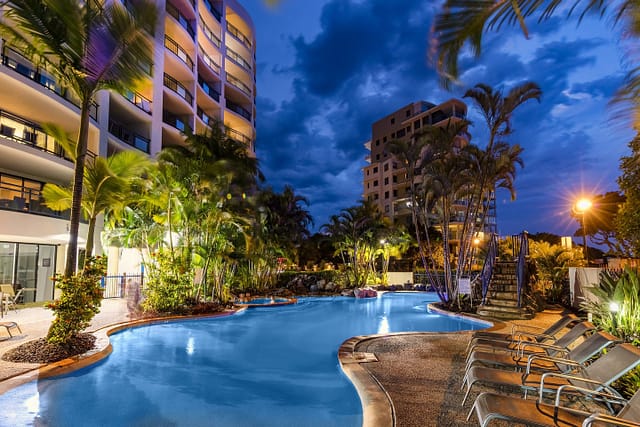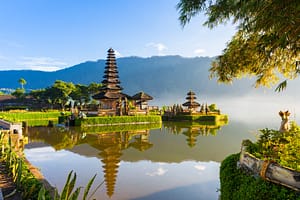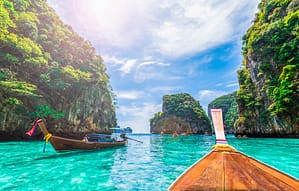While most people don’t immediately think of waterfalls when they imagine Australia’s bounty of natural attractions, they’re as much a part of the country’s landscape as the Great Barrier Reef and the iconic red soil of the outback.
Appearing in all shapes and sizes, from soothing trickles to gushing cascades, in everywhere from the tropical rainforests of Far North Queensland to the heart of the Northern Territory’s hot desert, Australia is home to thousands of these natural wonders.
So impressive is our vast collection of waterfalls that our cultural history is awash with references to their mesmerising beauty. In the late 18th and early 19th centuries, artists, authors and poets sought them out as inspiration for their works. Unable to completely shake the traditions of Romanticism, these artists regarded waterfalls as the ultimate expression of the sublime and the beautiful.
But what is it about flowing water that is so seductive? Join us as we explore some of the most spectacular waterfalls within driving distance of Wyndham’s properties in Sydney, Coffs Harbour and the Sunshine Coast, and discover why these natural phenomena have left people gushing for centuries.
“The song of the water doomed ever to roam…”
excerpt from The Waterfall by Australian bush poet, Henry Kendall
The Sunshine Coast’s Waterfalls
Perched in the hinterland high above the Sunshine Coast’s famous sun-drenched beaches, the quaint town of Maleny marks the gateway to some of the region’s most enchanting waterfalls. Gardners Falls and Kondalilla Falls are the perfect drive-to destinations for the warmer weather, offering a peaceful escape from the midday heat on a summer’s day. They also promise an evocative insight into the appeal these natural wonders have offered creative minds for hundreds of years.
Less than a 40-minute drive from WorldMark Golden Beach, Gardners Falls can be found just off the main road to Maleny on Obi Lane South. Following a sealed pathway through the bush from the carpark, you will come to a clearing that offers the best vantage point of the falls, which flow gently over wide, flat rocks in a series of misty cascades. The rock pools at the top of these cascades are popular with families as the water is generally calm and shallow enough for kids to swim safely.

For more adventurous swimmers, the freshwater lagoon at the base of the largest waterfall is one of the best places on the Sunshine Coast to cool off during a hot day. After a splash, enjoy a lazy afternoon picnicking on the banks of Obi Obi creek and let the serenity and fresh mountain air awaken your inner artist.
Further along the Blackall Range towards Montville is Kondalilla Falls National Park. Taking its name from the Aboriginal word for ‘rushing waters’, this mountaintop park is home to the spectacular Kondalilla Falls, where Skene Creek plummets 90 metres into the rainforest gully. The park is home to several walking tracks, including a 4.6 kilometre trail that takes you through the rainforest to the base of the waterfall.
Coffs Harbour’s Waterfalls
Winding 200 kilometres between Coffs Harbour and Armidale, Waterfall Way is regarded as one of the most scenic drives in Australia. Passing through no less than seven UNESCO-listed World Heritage areas (including more than 15 waterfalls), the aptly-named stretch is straight from the pages of a fairy tale.
The route takes you through the picturesque Bellinger Valley and onto the Dorrigo Plateau. Along the way you will be treated to a kaleidoscopic assortment of landscapes, including tropical rainforests dense with prehistoric ferns, dry, open gullies, farmlands peppered with doe-eyed cows; and a magical selection of waterfalls.
With so many areas to choose from, deciding which to visit can be a daunting task, especially if you’re only around for a couple of days. Luckily, there’s no bad choices – each of the cascades along Waterfall Way offer a unique, yet similarly evocative experience. One site, in particular, is so powerfully moving that its starring role in local culture is believed to date back more than 20,000 years.
Apsley Falls are two waterfalls on the Apsley River and the first in a series of dramatic drops in a deep gorge that make up part of the Oxley Wild Rivers National Park. The first drop is about 65 metres deep, and the second which is 800 metres along the gorge, plummets 58 metres to the bottom of the valley. The best view of the falls is accessible by foot via a 52-metre steel stairway that leads to an observation deck.
According to Aboriginal legend, the Rainbow Serpent created the gorge at Apsley in the Dreamtime. The local Dunghutti people say the Rainbow Serpent travelled underground from the foot of the falls to reappear upstream at the Mill Hole on the Apsley River in Walcha. The site is now commemorated with a Rainbow Serpent mosaic, made with the help of the local Aboriginal community. As you watch the sunlight flirting with the flowing water, you can see in the refracting turquoise, gold and purple hazy droplets the mystical Rainbow Serpent’s potent legacy.

Sydney’s Waterfalls
Sydney is much more than a concrete jungle; it plays host to dozens of spectacular waterfalls both in and around the city. Wattamolla is a 45-minute drive from Wyndham vacation Resorts Asia Pacific Sydney, in the eastern section of the Royal National Park. Famed for being the second-oldest national park in the world, there’s plenty here for the whole family including walking tracks, swimming holes, ample picnic grounds and a hypnotic waterfall. Plunging over a sheer cliff face into the sparkling freshwater lagoon below, the sight of this waterfall in the wet season is a visceral reminder of the sheer force of nature and is sure to get your creative juices flowing.
A little further afield, Govetts Leap in the Blue Mountains and Morton National Park in the greater Shoalhaven region boast some of the most inspiring waterfalls in New South Wales. The Blue Mountains region is rich in artistic and cultural history, dating back thousands of years to its original Aboriginal occupants. The landscape is scattered with evidence of their spiritual expression in the form of dreaming sites and rock art.
When you get there, you’ll see why everyone’s so in love with the scenery! The drive out to Govetts Leap is like a journey back through time to primeval Australia. The combination of dramatic landforms including staggering escarpments and dry ridges, with a rich colour palette – characterised by the blue haze the mountains are named after – is an intoxicating sight.

Govetts Leap lookout is one of the most visited viewpoints in the entire country, thanks to the panoramic views it offers of the Grose Valley and Bridal Veil Falls. At 180 metres, these falls are the highest in the Blue Mountains. Such breathtaking local scenery means it’s no wonder the Blue Mountains region is famous for being an artistic hotbed.
Morton National Park is two-and-a-half hours south of the CBD by car, and well worth the drive. The park is home to the impressive Fitzroy Falls, a visual and auditory display of power like no other. The thunderous roar of the impressive cascade is a compelling reminder of Mother Nature’s omnipotence.
In fact, the Morton National Park region is so spectacular that it served as the inspiration for some of Arthur Boyd’s most well-known oil paintings including ‘Waterfall’ and ‘rock face at Shoalhaven Valley’, as well as Australian poet Philip Durham Lorimer’s poem, Fitzroy Waterfall.
Near and more near to the precipice flowing,
Cometh a stream in its terrible flight,
Over the giddy height, where flow’rs are growing,
Falleth the torrent — incrushed in its might ;
Caught now by a rock, but still onward it dashes,
Spreading the width of its wonderful fall ;
Then down the deep chasm, grandly it crashes,
Wreathing like silver the moss-covered wall ;
Yes, with a terrible dashing and crashing,
Down in the basin of rocks far below
Its waters are foaming, boiling, and slashing,
As if they had met with their deadliest foe!Except from Fitzroy Waterfall by Australian bush poet, Philip Durham Lorimer
Fact File:
Banjo Patterson – one of Australia’s most famous bush poets – proposed to his sweetheart at Boonoo Boonoo Falls lookout in New South Wales.
Another Australian bush poet, Hendry Kendall, was the first Australian poet to draw his inspiration from the life, scenery, and traditions of the country around him. His well-known poem The Waterfall is an evocative description of an unknown waterfall.







